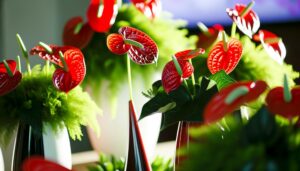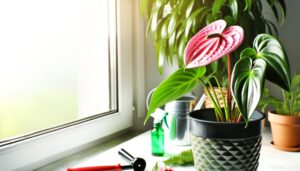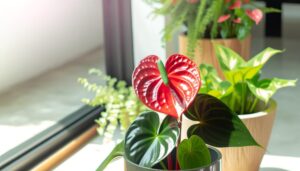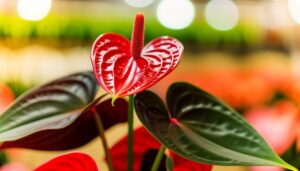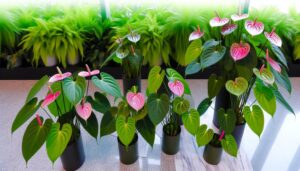7 Steps to Growing Anthuriums Outdoors in Hawaii
For successful anthurium growth in Hawaii, start by selecting a location with partial shade and protection from strong winds. Prepare the soil to be slightly acidic, rich in organic matter, and guarantee excellent drainage.
Plant your anthuriums 18-24 inches apart, mulching around their bases. Water consistently, ensuring the soil remains moist but not waterlogged.
Fertilize with a balanced, slow-release fertilizer every 6-8 weeks during the growing season. Monitor pests like aphids and use neem oil for control.
Regularly prune to maintain plant health and appearance. By following these steps, you'll create ideal conditions for your anthuriums to thrive.
Discover further insights on advanced care practices.
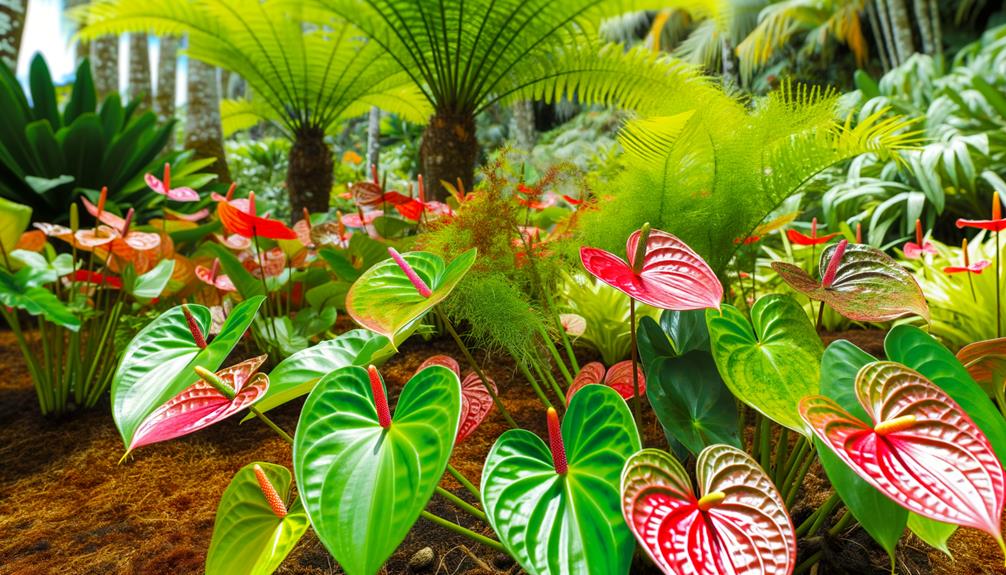
Key Takeaways
- Plant anthuriums in partial shade with filtered sunlight and protect from strong winds.
- Ensure soil is slightly acidic, well-drained, and amended with organic matter.
- Maintain consistent humidity and good air circulation to prevent fungal issues.
- Water regularly to keep soil moist but not waterlogged, and mulch to retain moisture.
- Fertilize with a balanced, slow-release 5-10-10 fertilizer every 6-8 weeks and supplement with high-phosphorus liquid fertilizer.
Choose the Right Location
Selecting the ideal spot for growing anthuriums outdoors in Hawaii is crucial, as they thrive best in locations that offer partial shade and protection from strong winds. You'll want to find a place where the sunlight is filtered, such as under taller trees or near structures that cast dappled shade. This helps prevent leaf scorching and stress.
Additionally, choose a spot away from strong, direct winds that could damage delicate leaves and flowers. A location with consistent humidity levels is beneficial, as anthuriums prefer moist air. Guarantee good air circulation to prevent fungal issues, but avoid overly exposed areas.
Prepare the Soil
Once you've chosen the perfect spot, it's time to focus on preparing the soil to secure that your anthuriums receive the nutrients and drainage they need.
Begin by testing your soil's pH; anthuriums thrive in slightly acidic conditions, ideally between 5.5 and 6.5. Amend the soil with organic matter like compost or aged manure to improve fertility and texture. Ensure superb drainage by incorporating perlite or coarse sand, as waterlogged soil can lead to root rot.
Work the amendments into the top 12 inches of soil, assuring an even distribution. Finally, level the soil surface to create a smooth planting bed.
Planting Anthuriums
To plant your anthuriums, dig individual holes that are twice the size of the root ball and spaced about 18-24 inches apart to provide adequate space for growth.
Gently remove each plant from its container, being careful not to harm the roots. Place the root ball into the hole, making sure the top is level with the surrounding soil. Backfill with a mix of native soil and organic compost, firmly pressing down to eliminate air pockets.
Next, add a layer of mulch around the base to retain moisture and reduce weed growth. Avoid piling mulch against the stem, as this can lead to rot.
Watering Guidelines
To keep your anthuriums thriving, establish a best watering schedule that suits Hawaii's climate.
Monitor soil moisture levels carefully by checking the top inch of soil; it should remain consistently moist but not waterlogged.
Prevent overwatering by ensuring proper drainage and adjusting your watering frequency based on seasonal rainfall.
Optimal Watering Schedule
Maintaining a perfect watering schedule for anthuriums outdoors in Hawaii requires a keen understanding of the local climate and the plant's specific moisture needs. Given Hawaii's tropical environment, your anthuriums will thrive with consistent and balanced watering. Aim to water them early in the morning or late in the afternoon to prevent excessive evaporation. Here's a guide:
| Time of Year | Frequency |
|---|---|
| Winter (Nov-Feb) | Every 5-7 days |
| Spring (Mar-May) | Every 3-5 days |
| Summer (Jun-Aug) | Every 2-3 days |
| Fall (Sep-Oct) | Every 3-5 days |
Ensure the soil is moist but not waterlogged. Use a gentle, steady stream to avoid damaging the roots. Regularly check the weather forecast and adjust as necessary—after all, Hawaii's rain showers can supplement your efforts.
Soil Moisture Levels
Regularly monitoring soil moisture levels is essential for ensuring your anthuriums receive the best amount of water without becoming waterlogged. Use a moisture meter to check soil, aiming for a reading that indicates moderate moisture. Stick the probe 2-3 inches deep, ensuring consistency across different areas.
You want the soil to feel slightly damp but not saturated. If you don't have a moisture meter, use your finger to gauge; the top inch should be dry before you water again. Water early in the morning to reduce evaporation and allow the plant to absorb moisture efficiently.
Preventing Overwatering Issues
Maintaining the thriving condition of your anthuriums involves understanding the delicate balance between adequate watering and overwatering, which can result in root rot and other complications. To prevent overwatering, utilize well-draining soil and water only when the top inch feels arid. Early mornings or late afternoons are optimal for watering.
Here's a quick reference table:
| Condition | Action |
|---|---|
| Soil feels dry | Water thoroughly |
| Soil is moist | Hold off on watering |
| Yellowing leaves | Inspect drainage and reduce water |
| Droopy leaves | Enhance watering frequency |
Keep an eye on the weather as heavy rainfall may saturate the soil. Adjust watering as necessary to prevent excess moisture. Regularly inspect the drainage holes to make sure they are not obstructed, fostering robust root systems. This equilibrium will maintain the vibrancy and flourishing of your anthuriums.
Fertilization Tips
Proper fertilization is essential for growing robust anthuriums in Hawaii's unique climate. This ensures they receive the necessary nutrients for vibrant growth and flowering. Use a balanced, slow-release fertilizer with an NPK ratio of 5-10-10 to promote healthy root development and vibrant blooms.
Apply the fertilizer every 6-8 weeks during the growing season. Be precise with application—over-fertilizing can burn delicate roots. Mix the fertilizer into the top inch of soil, taking care to avoid direct contact with the plant's stem.
Additionally, supplement with a liquid fertilizer high in phosphorus every 4-6 weeks to boost flowering. Always water your anthuriums thoroughly after fertilizing to help nutrients penetrate the soil and reach the roots efficiently.
Pest and Disease Control
To maintain healthy anthuriums, you need to identify common pests such as aphids, mealybugs, and spider mites.
Implement effective treatment methods like neem oil sprays and insecticidal soaps to manage these infestations.
Regular monitoring and prompt action will help you keep your plants thriving.
Common Pests Identification
Frequently, you'll encounter pests such as aphids, mealybugs, and spider mites when growing anthuriums outdoors in Hawaii, each requiring specific control measures to protect your plants.
Aphids appear as small, soft-bodied insects clustering on new growth, often secreting a sticky honeydew. Mealybugs, covered in a white, cotton-like substance, typically infest leaf axils and undersides. Spider mites are tiny, almost microscopic, and create fine webbing on the leaf surfaces.
Identifying these pests early is essential. Examine your anthuriums regularly, looking for signs like discolored or distorted leaves, sticky residue, or webbing. Understanding the behaviors and identifying features of these pests empowers you to act swiftly, ensuring your anthuriums thrive in Hawaii's unique climate.
Effective Treatment Methods
Implementing effective treatment methods for pests and diseases is crucial to maintaining the health and vibrancy of your anthuriums. Start by using insecticidal soap to manage aphids and spider mites. Spray thoroughly, making sure coverage on both sides of the leaves.
For bacterial blight, prune infected leaves immediately and apply a copper-based fungicide. Check the soil regularly for signs of root rot, and if detected, improve drainage and reduce watering frequency.
Neem oil is an excellent organic solution for combating thrips and mealybugs; apply it weekly for persistent infestations. Always keep your gardening tools sterilized to prevent disease spread.
Pruning and Maintenance
Regular pruning of your anthuriums is essential for maintaining their health and promoting vibrant blooms. Start by sterilizing your pruning shears with rubbing alcohol to prevent disease spread.
Focus on removing dead or yellowing leaves, as well as spent flower stems. Cut at the base of the stem, close to the main plant, ensuring a clean cut to avoid damage. Trim any leggy growth to encourage a bushier appearance.
Regularly check for pests like aphids and mealybugs, and remove any affected parts immediately. After pruning, apply a balanced fertilizer to support new growth.
Consistent maintenance won't only enhance your anthuriums' aesthetics but also improve air circulation, reducing the risk of fungal infections and boosting overall plant vigor.
Conclusion
You've now got the ultimate roadmap to growing anthuriums outdoors in Hawaii.
By choosing the perfect location, preparing the soil meticulously, planting with care, watering wisely, fertilizing effectively, and vigilantly controlling pests and diseases, your garden will transform into a paradise of vibrant blooms!
Don't forget to prune and maintain regularly.
Follow these steps, and you'll have anthuriums that could make even the Garden of Eden jealous!
Happy gardening!

